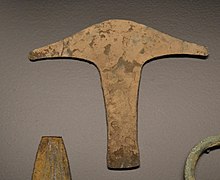
Metallurgy in pre-Columbian America is the extraction, purification and alloying of metals and metal crafting by Indigenous peoples of the Americas prior to European contact in the late 15th century. Indigenous Americans had been using native metals from ancient times, with recent finds of gold artifacts in the Andean region dated to 2155–1936 BC,[1] and North American copper finds being dated to approximately 5000 BC.[2] The metal would have been found in nature without the need for smelting, and shaped into the desired form using hot and cold hammering without chemical alteration or alloying. As of 1999, "no one has found evidence that points to the use of melting, smelting and casting in prehistoric eastern North America."[3](p 136)
In South America the case is quite different. Indigenous South Americans had full metallurgy with smelting and various metals being purposely alloyed. Metallurgy in Mesoamerica and western Mexico may have developed following contact with South America through Ecuadorian marine traders.[4]

- ^ Aldenderfer, Mark; Craig, Nathan M.; Speakman, Robert J.; Popelka-Filcoff, Rachel (2008). "4000-year-old gold artifacts from the Lake Titicaca basin, in southern Peru". PNAS. 105 (13): 5002–5005. doi:10.1073/pnas.0710937105. PMC 2278197. PMID 18378903.
- ^ Beukens, R. P.; Pavlish, L. A.; Hancock, R. G. V.; Farquhar, R. M.; Wilson, G. C.; Julig, P. J. (1992). "Radiocarbon dating of copper-preserved organics". Radiocarbon. 34 (3): 890–897. Bibcode:1992Radcb..34..890B. doi:10.1017/S0033822200064213.
- ^ Cite error: The named reference
Martin-1999was invoked but never defined (see the help page). - ^ Anawalt, Patricia Rieff (1992). "Ancient cultural contacts between Ecuador, West Mexico, and the American Southwest: Clothing similarities". Latin American Antiquity. 3 (2): 121. doi:10.2307/971939. JSTOR 971939. S2CID 164193577.